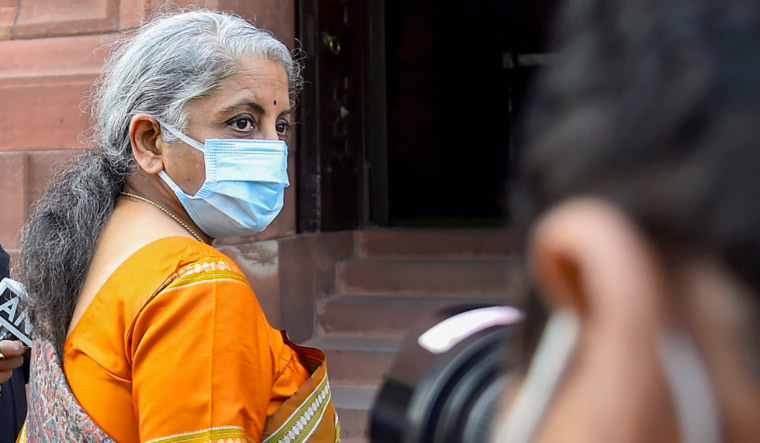The Covid-19 pandemic began spreading in early 2020 and hit global economies hard. The government as well as the Reserve Bank of India unleashed a raft of measures to offer relief as the pandemic upended the economy. But, two years later, Covid-19 continues to weigh.
In the last few weeks, there has been a resurgence of coronavirus cases, driven by a new fast spreading, but perhaps less severe, Omicron variant. In its backdrop, several economists have downgraded India’s GDP growth forecast by around 0.5 percent to 1 percent for the year ending March 2022 to take into account the impact of this new wave, especially on the services sector.
Given the continued uncertainties around the pandemic, in the upcoming Budget, Finance Minister Nirmala Sitharaman will be expected to do more to lift the economy and ensure its well oiled for growth even as the risk of new variants of the pandemic will continue.
But, how much fiscal room does Sitharaman have? In 2020-21, as the government unleashed economic relief measures, including higher spends on rural jobs scheme and free foodgrains, the fiscal deficit hit 9.3 percent in the year ended March 2021. Last year, the fiscal deficit target was slashed to 6.8 percent. But, it will be expected to reduce it further and stick to the fiscal consolidation roadmap, which envisages fiscal deficit at 4 percent by 2025-26.
“The main objective of the budget should be to create an environment by creating an enabling condition by giving higher weightage to short term stabilisation policy rather than long term policy,” said Soumya Kanti Ghosh, group chief economic adviser at State Bank of India.
Assuming that the government keeps the expenditure growth at 8 percent over 2021-22 estimates at Rs 38 lakh crore in 2022-23 financial year and receipts would grow by 10.8 percent, it would lead to fiscal deficit of around Rs 16.5 lakh crore or 6.3 percent of GDP in FY23, notes Ghosh.
Suvodeep Rakshit and Upasna Bhardwaj, economists at Kotak Institutional Equities also expect fiscal consolidation to be gradual and the government to target a fiscal deficit of 6.3 percent in the next financial year.
“We believe the government will continue favouring investment-driven growth and a slow-paced fiscal consolidation path that will also give it the flexibility to provide any additional support to the economy,” said Hemang Kapasi, head of equities at Sanctum Wealth.
A strong pickup in revenue collections between April-November at around Rs 13.6 lakh crore or close to 76 percent of the budgeted estimate is a big positive for the government this year. The net tax collections in the same period hit 73.5 percent of the budgeted estimate.
GST collections have also been strong; December was the sixth month in a row that GST revenue has been over Rs 1 lakh crore. But, the resurgence in the pandemic and the resulting restrictions are bound to have some impact on this in the Jan-March quarter.
The government also may not be able to meet its capital expenditure targets this year, feel economists.
“Achieving its FY22 capex target (Rs 6.2 lakh crore including supplementary grants) seems a tall ask. In order to meet its capex target, the government has to spend Rs 3.5 lakh crore in the last trimester of FY22, which is similar to its total capex in FY20 and double of Rs 1.8 lakh crore in the correspondent period of FY21,” noted Nikhil Gupta, chief economist at Motilal Oswal Financial Services.
With private sector investments unlikely to pickup meaningfully anytime soon, Sitharaman will be well aware that the government will have to continue to do the heavy lifting when it comes to big ticket investments. The government is likely to continue investing heavily in infrastructure development projects. At the same time, it may have to continue its social relief programmes, given the ongoing Covid wave and uncertainties on its future trajectory.
“The government will aim to increase capital expenditure, especially through defence, railways, roads, highways, and housing, and maintain pandemic and rural related expenditure through rural development (rural employment and rural roads), vaccine related, and agriculture and farmers’ welfare,” said the Kotak economists.
They expect growth of 4 percent and 19 percent in revenue expenditure and capex in FY23.
Sanctum’s Kapasi also feels there would be some measures to address the rural economy amid impending elections in several states and weakening demand signs which have been flagged by several companies in the last few days.
How much money does the government have in its kitty will also depend on the way its planned divestments pan out. Getting the LIC IPO over the line will be its biggest priority now. Of the planned divestment worth Rs 1.75 lakh crore, it has been able to raise just Rs 9,329 crore so far.
Ghosh of SBI says if the disinvestment of LIC goes through in the current financial year, Government might be ending the financial year with a large cash balance of Rs 3 lakh crore. This can come handy in supporting a large part of government fiscal deficit without taking recourse to market borrowings, he says.
He has pencilled in overall gross borrowings by the centre and states at around Rs 21 lakh crore in the year ending March 2023, compared with Rs 19.7 lakh crore this year and net borrowings of around Rs 14.8 lakh crore, versus Rs 15 lakh crore in the current fiscal.
If the LIC divestment does go through this year, then next year’s divestment targets will be lower than what it had targeted in FY22.
The Kotak economists expect disinvestments worth Rs 1 lakh crore next year. BPCL privatisation is likely to account for a major chunk of it, along with other possible stake sales in companies like Shipping Corporation, Container Corporation and Hindustan Zinc.





